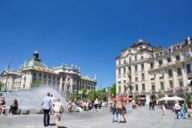
A shopping tour through the city centre of Munich starts often at Karlsplatz-Stachus and Karlstor (gate). The well-known Karlsplatz and the Karlstor are forming the western end of the pedestrian zone which leads to Marienplatz.
Karlstor on Stachus square is one of the three remaining gates in Munich's city walls, which were torn down at the end of the 18th century. Like Sendlinger Tor and Isartor, the gate was built when the city's second layer of fortification was erected in the 14th century. Until the pedestrian zone was built in 1972, it served as the main thoroughfare for traffic through the city.
If you're strolling through Karlstor on the way to the pedestrian zone, take a quick a break to look up for a moment: In the corners of the central arch, you will see little gargoyle-type figures of some famous Munich residents:
“Wer ko, der ko!” (“If you've got it, flaunt it!”)
One of them is the coachman Franz Xaver Krenkl, whose cheeky manner tested the tolerance of King Ludwig I. With his team of horses, which was far superior to the king's horses in terms of both splendour and power, he overtook the royal coach one day.
And as if this breach of etiquette was not enough, Krenkl then had the cheek to call out “Wer ko, der ko” (roughly translated as “If you've got it, flaunt it!”) to the aggrieved king. His taunt has now become a well-known phrase in Bavaria, meaning to be self-confident.
Karlsplatz-Stachus is one of the most famous squares in Munich. The square's two names have a funny story behind them.
When the Bavarian Wittelsbach line died out in 1777, the Elector Karl Theodor from the Palatinate region of Germany took over the government of Bavaria and made himself pretty unpopular with the people of the region on account of his political plans – after all, the new ruler was planning to exchange the whole of Bavaria for estates in Austria!
He provoked even more resentment among the people of Munich when he quickly started renaming various locations around the city after himself. This is where the names Karlstor and Karlsplatz came from.
However, the people of Munich rebelled and named the square of Karlsplatz after the nearby “Stachus” tavern which belonged to Eustachius Förderl. Even today, most local residents refuse to use the name Karlsplatz. The name “Stachus” even features in the electronic announcements on the tram and underground trains.

Speaking of transport: the saying “Da geht's ja zu wie am Stachus” has spread beyond Munich as way to describe a place where there's lots going on (similar to the phrase “It's like Piccadilly Circus” in the UK). These days, there's still a lot going on at Stachus but it's nowhere near as busy as it used to be: following the Second World War, Stachus reportedly had the highest density of traffic in Europe.
It did not quieten down until its eastern section, located just behind Karlstor gate, was turned into Munich's pedestrian zone in the run-up to the 1972 Olympic Games. These days, it is the starting point for Munich's shopping precinct (Kaufinger Strasse, Neuhauser Strasse, Marienplatz).